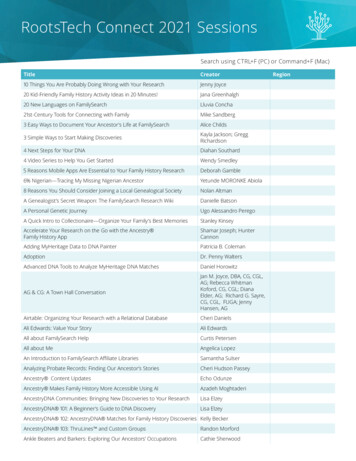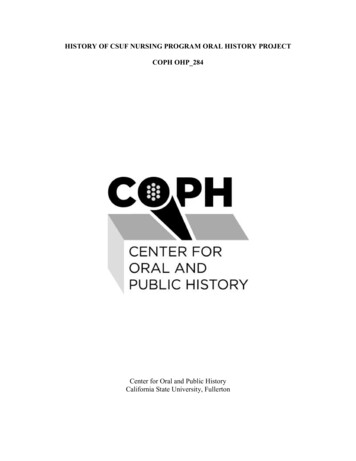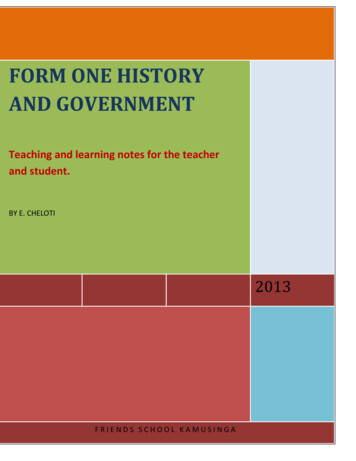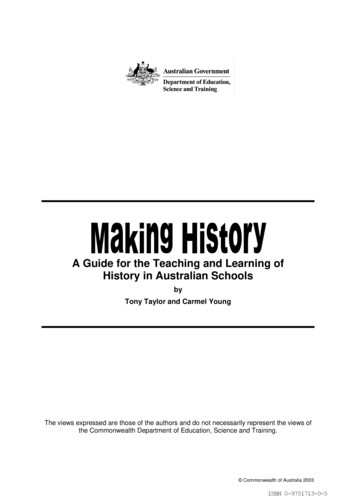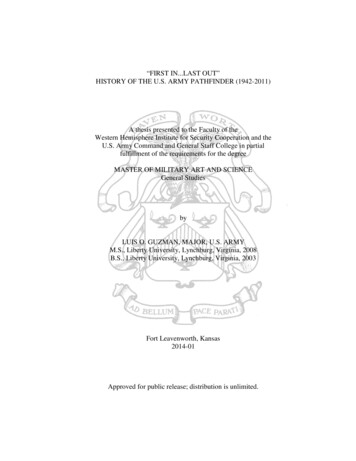
Transcription
“FIRST IN.LAST OUT”HISTORY OF THE U.S. ARMY PATHFINDER (1942-2011)A thesis presented to the Faculty of theWestern Hemisphere Institute for Security Cooperation and theU.S. Army Command and General Staff College in partialfulfillment of the requirements for the degreeMASTER OF MILITARY ART AND SCIENCEGeneral StudiesbyLUIS O. GUZMAN, MAJOR, U.S. ARMYM.S., Liberty University, Lynchburg, Virginia, 2008B.S., Liberty University, Lynchburg, Virginia, 2003Fort Leavenworth, Kansas2014-01Approved for public release; distribution is unlimited.
REPORT DOCUMENTATION PAGEForm ApprovedOMB No. 0704-0188Public reporting burden for this collection of information is estimated to average 1 hour per response, including the time for reviewing instructions, searching existing datasources, gathering and maintaining the data needed, and completing and reviewing this collection of information. Send comments regarding this burden estimate or any otheraspect of this collection of information, including suggestions for reducing this burden to Department of Defense, Washington Headquarters Services, Directorate forInformation Operations and Reports (0704-0188), 1215 Jefferson Davis Highway, Suite 1204, Arlington, VA 22202-4302. Respondents should be aware that notwithstandingany other provision of law, no person shall be subject to any penalty for failing to comply with a collection of information if it does not display a currently valid OMB controlnumber. PLEASE DO NOT RETURN YOUR FORM TO THE ABOVE ADDRESS.1. REPORT DATE (DD-MM-YYYY)2. REPORT TYPE3. DATES COVERED (From - To)21-05-2014Master’s ThesisAUG 2013 – MAY 20144. TITLE AND SUBTITLE5a. CONTRACT NUMBER“First In Last Out”History of the U.S. Army Pathfinder (1942-2011)5b. GRANT NUMBER5c. PROGRAM ELEMENT NUMBER6. AUTHOR(S)5d. PROJECT NUMBERLuis O. Guzman, Major, USA5e. TASK NUMBER5f. WORK UNIT NUMBER7. PERFORMING ORGANIZATION NAME(S) AND ADDRESS(ES)8. PERFORMING ORG REPORTNUMBERU.S. Army Command and General Staff CollegeATTN: ATZL-SWD-GDFort Leavenworth, KS 66027-23019. SPONSORING / MONITORING AGENCY NAME(S) AND ADDRESS(ES)10. SPONSOR/MONITOR’SACRONYM(S)11. SPONSOR/MONITOR’S REPORTNUMBER(S)12. DISTRIBUTION / AVAILABILITY STATEMENTApproved for Public Release; Distribution is Unlimited13. SUPPLEMENTARY NOTES14. ABSTRACTPathfinders were deployed in different theaters of war under totally different types of warfare, enemy idiosyncrasies,terrain, strategy and tactics, and as such they were called on to rapidly evolve and adapt to these different situations. Theprimary focus of this study is to provide a historical account and analysis of the U.S. Pathfinder from 1942 to what theyare today, in order to understand this adaptability. This study traces the late development of Pathfinder Operations by theU.S. Army during World War II (WWII), and selected employments of Pathfinders in both, the European and PacificTheaters of operations. This historical account will also explore Pathfinder Operations and employment during theVietnam and Afghanistan Wars. The research concept illustrates three archetypal historical examples: WWII, which wasto see the development of full-scale Airborne Operations; the Vietnam War, which was the proving ground for AirMobility Operations, and Afghanistan, were pathfinders added a new dimension to their capabilities by conductingpersonal recovery missions during Operation Enduring Freedom.The intent of this study is to give us a better optic on how the Pathfinder strategy has evolved over the course of 70years, which will allow us to determine their specific contribution to mission success. In doing so, it will provide insightsinto Pathfinder doctrine, “tactics, techniques and procedures,” strategy, technology and lessons learned from their originat the British, 21st Independent Parachute Company to today’s modern warfare. It aims to draw conclusions andrecommendations to optimize the employment of Pathfinder and Pathfinder Operations to meet the threats andchallenges of today’s ever-changing environment15. SUBJECT TERMSPathfinders, Airborne, Airmobility, Personal Recovery, World War II, Vietnam, Afganistan16. SECURITY CLASSIFICATION OF:a. REPORTb. ABSTRACTc. THIS PAGE(U)(U)(U)17. LIMITATIONOF ABSTRACT18. NUMBEROF PAGES(U)24819a. NAME OF RESPONSIBLE PERSON19b. PHONE NUMBER (include area code)Standard Form 298 (Rev. 8-98)Prescribed by ANSI Std. Z39.18ii
MASTER OF MILITARY ART AND SCIENCETHESIS APPROVAL PAGEName of Candidate: Major Luis O. GuzmanThesis Title: “First In Last Out”: History of the U.S. Army Pathfinder (1942-2011)Approved by:, Thesis Committee ChairCarlos Rodríguez, MSA, MemberLTC José E. Rodríguez, MBA, MemberPrisco R. Hernández, Ph.D.Accepted this 21st day of May 2014 by:, Director, Graduate Degree ProgramsRobert F. Baumann, Ph.D.The opinions and conclusions expressed herein are those of the student author and do notnecessarily represent the views of the U.S. Army Command and General Staff College orany other governmental agency. (References to this study should include the foregoingstatement.)iii
ABSTRACTFIRST IN LAST OUT: THE EVOLUTION OF U.S. ARMY PATHFINDERS FROM1942-2011, by MAJ Luis O. Guzman, 248 pagesPathfinders were deployed in different theaters of war under totally different types ofwarfare, enemy idiosyncrasies, terrain, strategy and tactics, and as such they were calledon to rapidly evolve and adapt to these different situations. The primary focus of thisstudy is to provide a historical account and analysis of the U.S. Pathfinder from 1942 towhat they are today, in order to understand this adaptability. This study traces the latedevelopment of Pathfinder Operations by the U.S. Army during World War II (WWII),and selected employments of Pathfinders in both, the European and Pacific Theaters ofoperations. This historical account will also explore Pathfinder Operations andemployment during the Vietnam and Afghanistan Wars. The research concept illustratesthree archetypal historical examples: WWII, which was to see the development of fullscale Airborne Operations; the Vietnam War, which was the proving ground for AirMobility Operations, and Afghanistan, were pathfinders added a new dimension to theircapabilities by conducting personal recovery missions during Operation EnduringFreedom.The intent of this study is to give us a better optic on how the Pathfinder strategy hasevolved over the course of 70 years, which will allow us to determine their specificcontribution to mission success. In doing so, it will provide insights into Pathfinderdoctrine, “tactics, techniques and procedures,” strategy, technology and lessons learnedfrom their origin at the British, 21st Independent Parachute Company to today’s modernwarfare. It aims to draw conclusions and recommendations to optimize the employmentof Pathfinder and Pathfinder Operations to meet the threats and challenges of today’sever-changing environment.iv
ACKNOWLEDGMENTSThis study has truly been a life experience, and I would like to express mygratitude and appreciation to all those who have made this journey a possibility. I wouldespecially like to thank the members in my committee Colonel (Ret) Carlos Rodriguez,who not only gave me the opportunity to attend Officer Candidate School, but also hasbeen an exceptional mentor, teacher and a great inspiration to me. LTC EstebanRodriguez who was always patient with me, while listening to my crazy thoughts andideas on how to pursue this project, and in turn, provided me the guidance and counsel toenhance the quality of this paper, making me a better writer. Dr. Prisco Hernandez whoseconstructive criticism and unending encouragement inspired me to pursue this historicalstudy.I would also like to acknowledge and give many thanks to Mr. Gary Fox,Director, Office of the Chief of Infantry, his perspective and insights on this paper wereimmeasurable. LTC Carl Bergmann, commander 1st Battalion, 507th Parachute InfantryRegiment, Mr. Luke Keating and the Cadre of the Pathfinder Course (1/507th PIR) fortheir support, professionalism and subject matter expertise on Pathfinder operations, mygratitude for your assistance and encouragement throughout this process.I would like to extend a special thanks to the staff at the Donovan ResearchLibrary for all of their attentiveness and support. I am particularly grateful for my peersunique outlooks and recommendations. I especially would like to thank Majors CharlesBrown, David O’Leary, Michael Rey and David Maldonado for their mentorship,friendship and continuous support.v
Lastly and most importantly, I would like to thank my wife Katina for alwaysstanding beside me. I could not have accomplished this journey without her quietpatience, encouragement, understanding and unwavering support. I am eternally gratefulto my mother for always believing in me and encouraging pursuing my dreams, andfinally I have no words to express for my gratitude to my stepfather Dr. Jose Medez-Coll,for his tireless uninterrupted guidance, support, motivation and constructive criticism,which has given me the drive and ability to tackle this challenge head on. I am trulythankful!vi
TABLE OF CONTENTSPageMASTER OF MILITARY ART AND SCIENCE THESIS APPROVAL PAGE . iiiABSTRACT. ivACKNOWLEDGMENTS .vTABLE OF CONTENTS . viiACRONYMS . ixILLUSTRATIONS . xiCHAPTER 1 INTRODUCTION .1Primary Research Question . 3Secondary Research Questions . 3Assumptions. 4Definitions . 4Scope . 6WWII . 6Vietnam . 7Afghanistan . 7Limitations . 7Delimitations . 8Significance of Study . 9Review of Literature . 9World War II . 11Vietnam . 13Afghanistan . 15Research Methodology . 15Stage One . 15Stage Two . 16CHAPTER 2 EVOLUTION TO FORMATION .18Evolution of Airborne Operations . 18Evolution of Air Mobility Operations . 26Evolution of Personnel Recovery Operations . 33Code of an Air Rescue Man . 33vii
CHAPTER 3 PATHFINDER ORIGINS .4021st Independent Parachute Company “The Original Pathfinder’s of the BritishAirborne” . 40CHAPTER 4 PATHFINDERS IN WWII: MEDITERRANEAN AND EUROPEANTHEATER OF OPERATIONS .55The Commencement of the U.S. Army Pathfinders . 55Operation Torch . 55Operation Husky . 62Operation Overlord . 82CHAPTER 5 PATHFINDERS IN WWII: PACIFIC THEATER OF OPERATIONS .111Airborne Operations in the Pacific Theater . 111The Phillippine Archipelago . 113Airborne Operation in Nadzab, New Guinea. 123Airborne Operation in Noemfoor Island . 128Airborne Operation in Leyte . 132Airborne Operation in Tagaytay Ridge . 138Airborne Operation in Corregidor . 142Airborne Operation at Los Banos . 148Airborne Operation in Camalaniugan, Luzon. 153CHAPTER 6 PATHFINDERS IN VIETNAM.166Battle of the Ia Drang Valley . 177CHAPTER 7 PATHFINDERS IN AFGANISTAN .196The Afghanistan Campaign . 196The Army’s Swiss army knife . 196Situation . 197Mission . 200Operational Plans . 203Operation Anaconda . 204Battle of Wanat . 205Personnel Recovery of Downed Aircraft . 207Vehicle Recovery Missions . 209Afgan Pathfinder Partnership Academy . 209Pathfinders In Afghanistan. 210CHAPTER 8 CONCLUSIONS AND RECOMMENDATIONS .215BIBLIOGRAPHY .227viii
ACRONYMSAAAir AssaultAOArea of OperationsCARPComputer Air Release PointCASClose Air SupportCCAClose Combat AttackCDSContainer Delivery SystemCLECentral Landing EstablishmentCLSCentral Landing SchoolCOSChief of StaffCSARCombat Search and RescueDARTDowned Aircraft Recovery TeamDZDrop ZoneDZSODrop Zone Safety OfficerDZSTDrop Zone Support TeamEZExtraction ZoneFRAGOFragmentary OrderGMRSGround Marked Release SystemGZGlider ZoneHEHeavy DropHLZHelicopter Landing ZoneLOCLines of CommunicationLZLanding ZoneMEDEVACMedical Evacuationix
NATONorth Atlantic Treaty OrganizationNVANorth Vietnamese ArmyOPCONOperational ControlOPORDOperation OrderPAVNPeoples Army of VietnamPFPathfinderPFOPathfinder OperationsPIPoint of ImpactPRPersonnel RecoveryPZPickup ZoneRAFRoyal Air ForceRBRadar BeaconRECONReconnaissance, ReconnoiterRPRelease PointSHAEFSupreme Headquarters Allied European ForcesSLOCSea Line of CommunicationSOPStandard Operating ProceduresTDPTouchdownTEWTTactical Exercise Without TroopsUSAFUnited States Air ForceUSMCUnited States Marine CorpsUSNUnited States NavyVCViet CongVIRSVerbally Initiated Release Systemx
ILLUSTRATIONSPageFigure 1. Leonardo da Vinci Codex Atlanticus Manuscript (Parachute) .19Figure 2. Members of the U.S. Army Airborne Test Platoon .26Figure 3. Leonardo da Vinci Codex Atlanticus Manuscript (Helicopter) .27Figure 4. One of the First Helicopters Constructed by French Pioneer Paul Cornu .29Figure 5. Recovery of a Downed Airmen (Chicago Air Meet 1911) .34Figure 6. 21st Independent Parachute Company Pathfinders.40Figure 7. Eureka AN/PPN-1A .50Figure 8. Aldis Lights .52Figure 9. Operation Torch: Invasion Plan .61Figure 10. Operation Torch: Airborne Drop/Parking area of U.S. Planes .62Figure 11. Officers who played a role in the American PathfinderExperimental Program .79Figure 12. Operation Husky .81Figure 13. Allied Invasions of North Africa and Sicily Overview .82Figure 14. Operation Overlord: The Invasion of Normandy.88Figure 15. Operation Neptune: Assault Area (DZ locations for 82nd/101st AirborneDivisions) .94Figure 16. Operation Neptune: (101st Airbrone Division Drop) .101Figure 17. Operation Neptune: (82nd Airbrone Division Drop) .103Figure 18. Airborne Operation in Nadzab, New Guinea .127Figure 19. Airborne Operation in Noemfoor Island .131Figure 20. Airborne Operation in Noemfoor Island .131Figure 21. Japanese Attacks on Burauen Airfield .137xi
Figure 22. 11th Airborne Division Last Battle on Leyte (Purple Heart Hill) .138Figure 23. Airborne Operation in Tagaytay Ridge.142Figure 24. Airborne Operation on Corregidor.146Figure 25. Airborne Operation in Corregidor .148Figure 26. Los Banos Internment Camp Sketch Map .150Figure 27. Airborne Operation at Los Banos .153Figure 28. Airborne Operation in Camalaniugan, Luzon .157Figure 29. Airborne Operation in Camalaniugan, Luzon .158Figure 30. Reconnaissance Flight conducted prior to executing the Battle ofIa Drang Valley .185Figure 31. Battle of Ia Drang Valley (LZ X-RAY) .190xii
CHAPTER 1INTRODUCTIONWar undergoes a constant evolution. New weapons create new forms of combat.To foresee this technical evolution accurately, to assess the effect of a newweapon system on the course of a battle and to employ it before the enemy does,are essential conditions of success. 1― Official German Manual on Troop Leadership(Truppenführung) prior to World War IIThe evolution of the United States (U.S.) Army Pathfinder has a unique history.Its origin can be traced to World War II (WWII) with the U.S. Army’s development ofairborne units that would parachute behind enemy lines to carry out their assignedmissions.One of the primary lessons learned from these parachute drops was that in orderto drop large-scale airborne units accurately, and prevent the scattering of paratroopersover an expanded area; a small group of specially trained paratroopers would be neededto lead the way. These paratroopers would be trained and equipped with homing devicesand visual aids to aid pilots to navigate to their designated Drop Zones (DZ) or GliderZones (GZ). These paratroopers were given the classification ‘Pathfinders.’ From here onPathfinders would descend behind enemy lines and spearhead airborne assaults. Italy,France and Holland would witness their original employments. Their efforts led toincalculable improvements in parachute drop accuracy and mission success.Pathfinders continued to evolve during the Vietnam War by attaching Pathfinderdetachments and companies to ground units. These Pathfinders provided navigationalassistance and control of Army aircraft (Helicopters) to their designated landing zones(LZ), to include support for all phases of airmobile operations. Pathfinders continued to1
be employed throughout the Gulf Wars and Afghanistan. In Afghanistan, duringOperation Enduring Freedom (OEF) Pathfinders added a new dimension to theircapabilities by conducting Personnel Recovery (PR) missions.To explain the formation of Pathfinders and Pathfinder Operations (PFO) it isessential to understand how and why this strategy emerged. The primary focus of thisstudy is to provide a historical account and analysis of the U.S. Army Pathfinder from1942 to what they are today. Pathfinders were deployed in different theaters of war undertotally different types of warfare, enemy idiosyncrasies, terrain, strategy and tactics, assuch they were called on to rapidly evolve and adapt to these different situations.The aim of this analysis is to establish Pathfinders ability to rapidly adapt tochanging situations as one of its main virtues, and to encourage continued training andnurturing of these units; with a special emphasis on their capability to adapt to theunforeseen changes in today’s complex environment, which presents a wide range ofthreats and challenges that will emanate from diverse populations.This study traces the development of Pathfinder operations by the U.S. Armyduring WWII, and selected employments of Pathfinders in both, the European and Pacifictheaters of operations. This historical account will also explore selected Pathfinderoperations and employment during the Vietnam and Afghanistan Wars. The researchconcept illustrates three archetypal historical examples: WWII, which was to see thedevelopment of full-scale airborne operations; the Vietnam War, which was the provingground for airmobility operations, and Afghanistan, were Pathfinders added a newdimension to their capabilities by conducting personnel recovery missions during OEF.2
It is a case study of how the Pathfinder strategy has evolved over the course of 70years, and how the formation of Pathfinders and Pathfinder operations have adapted tothe changes of different types of warfare. In doing so, it will provide insights intoPathfinder doctrine, “tactics, techniques and procedures,” (TTP) strategy, technology andlessons learned from their origin at the British, 21st Independent Parachute Company totoday’s modern warfare. Additionally, the author will illustrate three historical examples:the evolution of airborne, airmobile and personnel recovery operations, in order to gainan appreciation on how these different types of warfare evolved throughout history.Primary Research QuestionHas Pathfinder’s high adaptability and employment been a major factor formission success in the theater of war where they have been deployed?Secondary Research QuestionsTo ultimately answer the primary question, we must understand, analyze andassess the following secondary questions:1. Why did the formation of Pathfinders emerge?2. How did Pathfinder operations evolve, adapt, and contribute to airbornewarfare in WWII?3. How did Pathfinder operations transform, evolve, adapt and contribute toairmobility warfare in the Vietnam war?4. What unique capability did Pathfinders execute in support of the war inAfghanistan?3
5. Did Pathfinder operations evolve and adapt to the different theaters of wareffectively?6. Were they of any significance in assisting the assault forces to achieve theiroverall objectives?7. What aspects influenced mission success or failure?8. Will Pathfinder operations still be a useful type of warfare to meet the threatsand challenges of future conflicts?AssumptionsThe study of this thesis is historical, all of the research and content is derivedfrom archived data, previously written publications, and field research through first handaccounts. No assumptions need to be made at this time. All conclusion derived are basedexclusively on historical facts.DefinitionsAir Assault. A vertical envelopment is conducted to gain a positional advantage,to envelop or to turn enemy forces that may or may not be in a position to oppose theoperation. Ideally, the commander seeks to surprise the enemy and achieve an unopposedlanding when conducting a vertical envelopment. However, the assault force mustprepare for the presence of opposition. At the tactical level, vertical envelopments focuson seizing terrain, destroying specific enemy forces, and interdicting enemy withdrawalroutes. 2Air Assault Operation. Operation in which assault forces (combat, combatservice, and combat service support), using the firepower, mobility, and total integration4
of helicopter assets, maneuver on the battlefield under the control of the ground or airmaneuver commander to engage and destroy enemy forces or to seize and hold keyterrain. 3Airborne. Personnel, troops especially trained to effect, following transport by air,an assault debarkation, either by parachuting or touchdown. 4Airborne Operation. An operation involving the air movement into an objectivearea of combat forces and their logistic support for execution of a tactical, operational, orstrategic mission. The means employed may be any combination of airborne units, airtransportable units, and types of transport aircraft, depending on the mission and theoverall situation. 5Amphibious Operation. A military operation launched from the sea by anamphibious force, embarked in ships or craft with the primary purpose of introducing alanding force ashore to accomplish the assigned mission.6Drop Zone. A specific area upon which airborne troops, equipment, or suppliesare airdropped. 7Guerrilla Warfare. Military and paramilitary operations conducted in enemy-heldor hostile territory by irregular, predominantly indigenous forces. 8Landing Zone. Any specified zone used for the landing of aircraft. 9Personnel Recovery. The aggregation of military, civil, and politicalefforts to obtain the release or recovery of personnel from uncertain or hostileenvironments and denied areas whether they are captured, missing, or isolated. Thatincludes US, allied, coalition, friendly military, or paramilitary, and others as designatedby the National Command Authorities. Personnel recovery (PR) is the umbrella term for5
operations that are focused on the task of recovering captured, missing, or isolatedpersonnel from harm’s way. PR includes, but is not limited to, theater search and rescue;combat search and rescue; search and rescue; survival, evasion, resistance, and escape;evasion and escape; and the coordination of negotiated as well as forcible recoveryoptions. PR can occur through military action, action by nongovernmental organizations,other US Government-approved action, and/or diplomatic initiatives, or through any ofthese. 10Pickup Zone. A geographic area used to pick up troops or equipment byhelicopter. 11Reconnaissance. A mission undertaken to obtain, by visual observation or otherdetection methods, information about the activities and resources of an enemy orpotential enemy, or to secure data concerning t
into Pathfinder doctrine, tactics, techniques and procedures," " strategy, technology and lessons learned from their origin at the British, 21st Independent Parachute Company to today's modern warfare. It aims to draw conclusions and recommendations to optimize the employment of Pathfinder and Pathfinder Operations to meet the threats and





